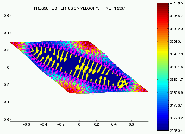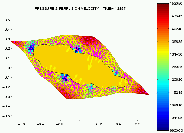
engineering & technology publications
ISSN 1759-3433
PROCEEDINGS OF THE SEVENTH INTERNATIONAL CONFERENCE ON COMPUTATIONAL STRUCTURES TECHNOLOGY
Numerical Modelling and Homogenized Constitutive Law of Large Deforming Porous Media
+Department of Mechanics,
*New Technologies Research Centre,
University of West Bohemia, Pilsen, Czech Republic
The homogenization for
![]() is based on the two scale
convergence method. We obtain the local "cell-problems" to be solved for
local RVEs, denoted by
is based on the two scale
convergence method. We obtain the local "cell-problems" to be solved for
local RVEs, denoted by
![]() ; these are related to specific points
of the macroscopic domain
; these are related to specific points
of the macroscopic domain ![]() . The fields (displacements, pressures and
perfusion velocities) in the microscopic cells are computed by solving the
associated boundary value problems. In the context of thermodynamics, in this
way one introduces the internal variables which present the relationship
between the macro- and microscopic responses and which account for history of
deformation. In particular, for all the fields we define the characteristic and
the particular responses (e.g. for displacement
. The fields (displacements, pressures and
perfusion velocities) in the microscopic cells are computed by solving the
associated boundary value problems. In the context of thermodynamics, in this
way one introduces the internal variables which present the relationship
between the macro- and microscopic responses and which account for history of
deformation. In particular, for all the fields we define the characteristic and
the particular responses (e.g. for displacement
![]() ,
,
![]() and
and
![]() , respectively), so that
the local cell
, respectively), so that
the local cell ![]() is updated by
is updated by
![]() ,
where
,
where
![]() is the local macroscopic deformation. In
a similar sense we decompose also the microscopic response of pressures and
velocities.
is the local macroscopic deformation. In
a similar sense we decompose also the microscopic response of pressures and
velocities.
By virtue of the homogenization method, cf. [2],
one obtains the following effective
material coefficients: the homogenized tangent stiffness tensor
![]() as a function of the characteristic responses and of the time discretization
step
as a function of the characteristic responses and of the time discretization
step ![]() , the averaged Cauchy stress
, the averaged Cauchy stress ![]() computed using
microscopic stress, and the retardation stress
computed using
microscopic stress, and the retardation stress
![]() as a
function of the particular microscopic response.
as a
function of the particular microscopic response.
As a particular microstructure we consider material with quasi-periodic
distribution of fluid capsules embedded in the porous matrix. In this situation
the macroscopic pressure ![]() is that in the microscopic capsules. The
local RVE problems describe coupled deformation-diffusion processes in cell
is that in the microscopic capsules. The
local RVE problems describe coupled deformation-diffusion processes in cell
![]() , accounting for the fluid flow in the matrix compartment and through
membranes of the capsules. On the macroscale we compute
, accounting for the fluid flow in the matrix compartment and through
membranes of the capsules. On the macroscale we compute
![]() and
and
![]() such that the UL
equilibrium conditions hold.
Due to large deformation, only local periodicity of the microstructure is
preserved, so that the microscopic responses should be computed for many
micro-cells associated with integration points of the macroscopic finite
element model. We have dealt with two approaches to overcome this hurdle: 1)
parallel algorithm for computation of micro-responses, which is discussed in
this paper; 2) use of sensitivity analysis [3] for an
approximate recovery of homogenized coefficients. The latter approach has
proved its viability in application to hyperelastic materials
[2].
such that the UL
equilibrium conditions hold.
Due to large deformation, only local periodicity of the microstructure is
preserved, so that the microscopic responses should be computed for many
micro-cells associated with integration points of the macroscopic finite
element model. We have dealt with two approaches to overcome this hurdle: 1)
parallel algorithm for computation of micro-responses, which is discussed in
this paper; 2) use of sensitivity analysis [3] for an
approximate recovery of homogenized coefficients. The latter approach has
proved its viability in application to hyperelastic materials
[2].
The multiscale approach seems to be promising for application in biomechanics, where the coupling between dissipative processes related to the induced viscoelasticity and microflow is essential, and is responsible for redistribution of dissolved species with relationships to growth and tissue remodelling. In Figure IRefrohan:fig the deformation and perfusion through microstructure of smooth muscle cell is illustrated for two time instants of the contraction process. We discuss numerical aspects of the modelling. (The research has been supported generously by the project LN00B084 of The New Technologies Research Centre in Pilsen.)
- 1
- Murad, A.M., Guerreiro, J.N., Loula, A.F.D., "Micromechanical computational modelling of secondary consolidation and hereditary creep in soils", Comput. Methods Appl. Mech. Engrg. 190, 1985-2016, 2001. doi:10.1016/S0045-7825(00)00218-8
- 2
- Rohan, E., "Mathematical modelling of soft tissues", Habilitation thesis, University of West Bohemia, Plzen, 2002.
- 3
- Rohan, E., "Sensitivity strategies in modelling heterogeneous media undergoing finite deformation", Math. and Computers in Simul., 61, 261-270, 2003. doi:10.1016/S0378-4754(02)00082-4
purchase the full-text of this paper (price £20)
go to the previous paper
go to the next paper
return to the table of contents
return to the book description
purchase this book (price £135 +P&P)

